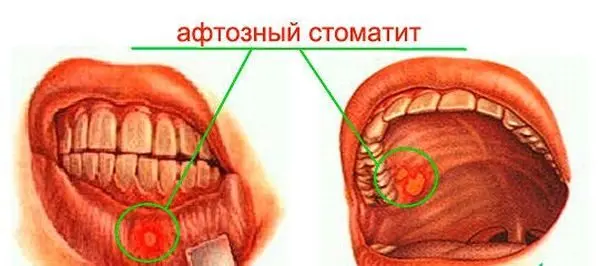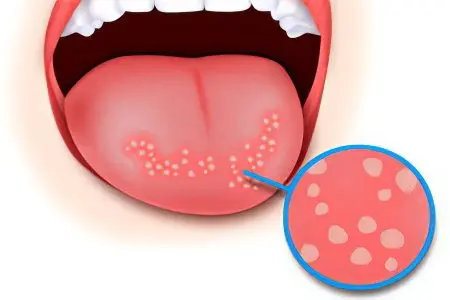Contents
Aphthous stomatitis is not only unpleasant, but also quite painful. Ulcers that form in the mouth make it difficult to eat. You should not treat aphthous stomatitis by traditional medicine methods on your own. This can be not only dangerous, but also threatens the transition of the disease into a chronic form.
Aphthous stomatitis has several varieties. To clarify the diagnosis and begin the correct treatment, you need to contact the doctor.
What is aphthous stomatitis?
Aphthous stomatitis is an inflammation of the mucous membrane of the oral cavity. So-called aphthae are formed on it, that is, small white ulcers. Each ulcer is surrounded by a red rim. Afta can be oval and round. Sometimes they are formed one by one, and sometimes several. The main symptom of the disease is pain and burning in the mouth. These unpleasant symptoms increase in intensity during meals. Aphthae heal for a long time, the recovery time for damaged tissues can be extended by 10-14 days. After the aphthae disappear, a healthy, intact mucosa will remain in their place.
You can get rid of the usual aphthous stomatitis completely. In the chronic form of the disease, it will only be possible to achieve a long remission. This will be considered a success. The approach to treatment should be comprehensive. In addition to medicines, you can use the methods of traditional medicine, but only after consulting a doctor. If therapy is absent for a long time, then acute aphthous stomatitis will turn into a chronic form and will constantly recur. Infection with aphthous stomatitis occurs in the household way.

Most often, sores appear on the inside of the cheeks and lips. This is due to the fact that these places are more prone to injury. Mucous membranes may show scratches and bite marks. Ulcers can also form on the tongue, but this happens less frequently. Sometimes aphthous stomatitis leads to an increase in body temperature and increased weakness. Normally, the oral cavity should clear in 8-10 days.
Causes of aphthous stomatitis

To date, the reasons for the formation of aphthae in the mouth are unknown. Doctors suggest that there is a connection between the disease and the state of the immune system. At some point, the immune system ceases to recognize the molecules of its own saliva, begins to actively produce lymphocytes against them, which leads to the formation of ulceration sites.
Often aphthae are formed in the presence of a focus of chronic infection in the body. It can be concentrated on the tonsils, in the throat, in the digestive tract.
Risk factors that increase the likelihood of formation of aphthae in the oral cavity include:
Change of climatic zones.
Difficult working conditions that overload a person both emotionally and physically.
Prolonged stress and frequent emotional upheavals.
In general, any factors that affect the state of the immune system can cause aphthous stomatitis. The lower the body’s resistance, the higher the likelihood of stomatitis.
Symptoms of aphthous stomatitis

Depending on the stage of development of the disease, its symptoms will vary.
When aphthous stomatitis has just begun to develop, this process is characterized by the following features:
Weakness, deterioration of health.
Decreased appetite.
Increase in body temperature. As a rule, it remains within 38 ° C.
Enlarged lymph nodes in size. The cervical, submandibular and occipital plexuses may be involved in this process.
The appearance of areas of redness in the mouth.
If aphthae appear on the tongue, then this gives a person special discomfort. They not only hurt, but also contribute to increased salivation, as well as a distortion of taste. Difficulty in eating.
Stage of the disease
There are several stages in the development of aphthous stomatitis:
Initial stage. During this period, the patient’s body temperature rises, general well-being worsens, lymph nodes swell, appetite disappears.
Second stage. Reddish painful areas appear in the mouth, in place of which ulcers subsequently form.
Stage of the main manifestations of stomatitis. Ulcers in size reach 5 mm, have a gray-white color. At this time, elevated body temperature and general malaise persist.
Stage of resolution of the ulcer. The defect is cleared of plaque, after which it disappears. At this stage, all the unpleasant symptoms of the disease begin to fade away.
The average duration of aphthous stomatitis is 8-16 days. After this time, the mucous membrane of the oral cavity is restored, there are no scars or scars on it. This is what happens normally. However, if a person has developed a deforming form of aphthous stomatitis, then after the resolution of ulcerative defects, the soft tissues of the lips and the inner surface of the cheeks may change slightly.
Classification of the disease
Aphthous stomatitis is divided into 2 types: acute and chronic.

Acute stomatitis is called acute gingivostomatitis. It is caused by viral infections. At the same time, the body temperature rises in a person, the lymph nodes become inflamed. Ulcers hurt, cause a burning sensation in the mouth. Increased discomfort while eating. At the same time, appetite decreases, general well-being worsens.
As for the chronic form of stomatitis, its causes today remain unexplored to the end. Doctors suggest that adenoviruses provoke the formation of aphthae. It is believed that such a problem is of an autoimmune nature. Other experts insist that stomatitis is caused by specific staphylococci. However, the chronic form of the disease is always diagnosed in people with a weak immune system.
Chronic stomatitis rarely leads to an increase in body temperature. Most often, it remains normal, as well as the lymph nodes. Ulcers heal quickly, within 2-7 days.
By itself, aphthous stomatitis has several varieties. Depending on this, its symptoms will vary:
Fibrinous. With fibrinous stomatitis, ulcerative defects are formed in the oral cavity, covered with a grayish coating. They heal in 1-2 weeks. In the future, the disease may recur. This happens throughout the year. Then exacerbations happen more and more often. If there is no treatment, then the person will constantly experience symptoms of stomatitis.
Necrotic. Necrotizing stomatitis accompanies severe diseases of the body. In the area of inflammation, cells begin to die. At first, the ulcers do not hurt, but as they grow, the person begins to experience serious discomfort. Such defects heal for a long time – from 2 weeks to a month.
Glandular. Glandular stomatitis has a relationship with the salivary glands. Ulcers are very painful and take a long time to heal. Moreover, even with competent therapy, the process of restoring the mucous membranes is delayed.
Scarring. With the cicatrizing form of stomatitis, small ulcers form in the mouth. They quickly increase in size and can reach 3 cm in diameter. After their resolution, scar tissue remains on the mucous membranes. Treatment should be long, as this form of the disease is considered one of the most difficult.
Deforming. The disease has a severe course. Ulcers with deforming stomatitis are large, poorly amenable to medical correction. After recovery, scars remain on the mucous membranes, which can deform them.
Diagnostics
To make a diagnosis, you need to visit a dentist. If an ulcer has formed in a child, then you need to go to a pediatric dentist. As a rule, determining the form of the disease is not difficult, since aphthous stomatitis has characteristic symptoms. A general examination of the oral cavity is sufficient for the doctor. To find out the cause of the violation, you will need to donate blood for a general and biochemical analysis.
Treatment of aphthous stomatitis
Treatment of stomatitis includes the treatment of the oral cavity with medications. For this, antibacterial and anti-inflammatory agents are used, which destroy the pathogenic flora and accelerate the recovery process.
Sometimes oral medications are required, but they must be prescribed by a doctor. An obligatory component of therapy is rinsing the oral cavity with drugs.
[Video] Life is great! Aphthous stomatitis:









